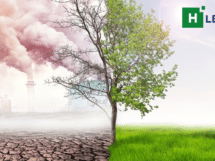It has been found that climate change can both facilitate zoonotic spillovers and have an effect on transmission chains
Summer normally spawns its own set of illnesses worldwide. Heat and humidity can trigger asthma, dengue, malaria, hyperthermia, skin conditions along with others. But now with the rise in temperature due to climate change, new infections are surfacing.
According to Linda Rudolph, director of the Center for Climate Change and Health at the Public Health Institute, rising temperatures and variations in rainfall can alter a region’s hospitability to disease carriers like mosquitos and ticks, which could cause malaria, dengue, and Lyme disease to spread into areas previously not at risk. Dr. Rudolph says that the “warmer temperatures can also affect how quickly some pathogens grow and replicate.” One of the biggest threats of the rising temperatures due to climate change, Dr Rudolph points out, is the migration of animals from one place to another which brings them into contact with humans and makes it possible to share germs with humans or other animals.
“As the planet gets hotter, some animals are moving toward the poles, coming into contact for the first time with different animals, and in some cases with people,” she says.
Is Covid-19 pandemic or for that matter, the new health emergency Monkeypox also the result of climate change? There is no direct evidence yet. But it has been found that climate change can both facilitate zoonotic spillovers and have an effect on transmission chains. With Covid-19, however, while the tropical countries remained relatively untouched, temperate regions were badly impacted.
Deforestation, for example, can be an indirect trigger for the pandemics. Denuding of forests, says the Director of Harvard Chan C-CHANGE Dr Aaron Bernstein, is the largest cause of habitat loss worldwide. This, in turn, forces animals to migrate and potentially contact other animals or people and share germs. Large livestock farms, Dr Bernstein underlines, can also serve as a source for spillover of infections from animals to people.
Same is the case with the increasing air pollution. Quoting research from Rachel Nethery, Xiauo Wu, Francesca Dominici and other colleagues at Harvard Chan, Dr Bernstein says that the people who live in places with poor air quality are more likely to die from COVID. Another study has found that a small increase in long-term exposure to PM2.5 (particles that have diameter less than 2.5 micrometres) in the United States leads to a large increase in the COVID-19 death rate. There are many more researches that validate this conclusion.
As for the future, the more the world’s temperature rises, the more infectious diseases are anticipated to spread. According to a study published in Nature in August, over half of the known human pathogenic diseases can be aggravated by climate change. The study elaborates that the “societal disruption caused by pathogenic diseases, as clearly revealed by the COVID-19 pandemic, provides worrisome glimpses into the potential consequences of looming health crises driven by climate change.”
But there isn’t yet sufficient awareness of the grim toll that climate change and the consequent rise in the temperature can take on health. As things stand, climate change seems ineluctable in the absence of a concerted international effort to avert it. We can only hope that the next year’s COP28 summit in Dubai not only drives a more determined global climate action but also highlights the less emphasized health consequences of climate change.
















